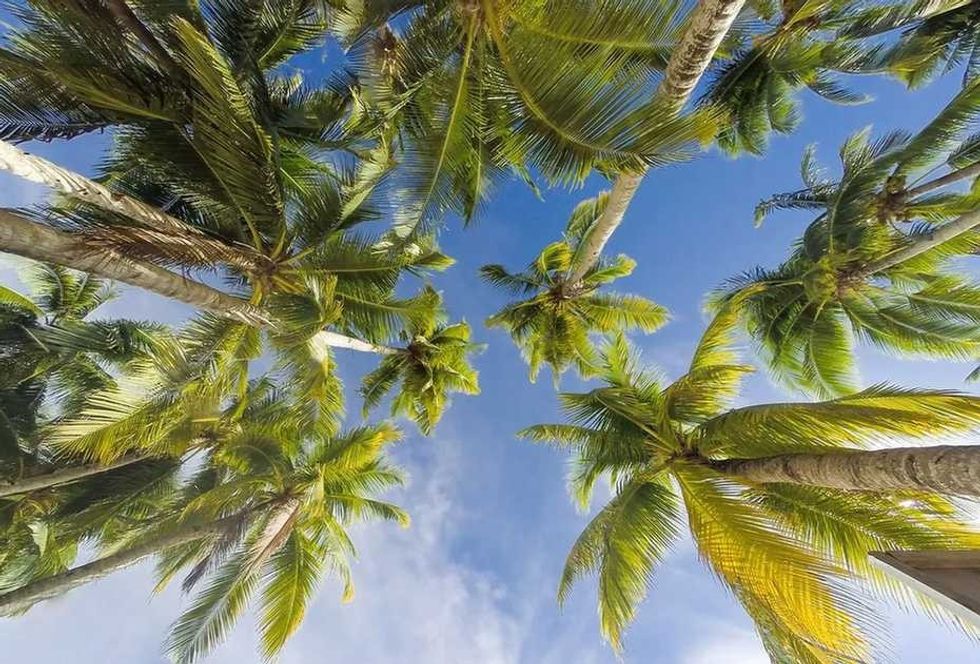Palms are flowering evergreen plants. They are angiosperms that belong to the Arecaceae family.
Palm trees are said to have appeared during the late Cretaceous era, which is 80 million years ago. The word 'palm' is derived from the old French word 'Palme' and Latin word 'Palma', which means 'of a hand'.
Palm trees get their names from their leaves, which are similar to the shape of the fingers on our hands. There are around 2,600 species in the palm family. They are widespread and found in a variety of habitats.
A majority of the species are restricted to the tropic and subtropic regions. Only 130 species are found in other regions. There are five subfamilies under which the palm species are grouped, namely: Arecoideae, Calamoideae, Ceroxyloideae, Coryphoideae, and Nypoideae.
Arecoideae is the largest of all the subfamilies, containing over 50% of the palm species. Ceroxyloideae contains climbing palms.
The Nypoideae subfamily only has one member, the nipa palm (Nypa fruticans). Palm trees with small or medium-sized flowers are grouped under Ceroxyloideae. Coryphoideae is a paraphyletic group, and phytelephantoideae is a monoecious group.
How do palm trees grow?
Palm trees have primary growth. It refers to the growth from the edges of the shoots and from the roots. Palm trees, unlike other trees, do not undergo secondary growth. Instead, they use augmentation of parenchyma that helps to develop thick trunks without having to undergo actual secondary growth.
Palm trees grow from the top. New growth occurs on the top, with the oldest leaves at the bottom. This happens since the minerals and nutrients travel upwards from the old leaves.
Palm trees grow slowly. There are several species of palm trees. Though the growth rate depends on the temperature and species, most palms grow slowly. It takes three to eight months for the seeds to germinate.
The stems of a palm tree can be clustered or solitary. While most of them shoot up straight, some of them can grow horizontally along the ground.
Environments Palm Trees Grow In
Palm trees can tolerate various climates. But they are mainly found in tropical and subtropical regions. They can withstand the cold, but do not do well in extremely cold conditions.
Palm trees thrive in environments with well-drained soils. Since palm trees are not deep-rooted, they require sandy loam. Sticky soil can hinder root growth.
Not all palm trees need direct sunlight. Coconut palm and Buccaneer palm grow well in shade. Other species like the date palm, royal palm, and Torbay palm need full and direct sunlight to grow. Many species, like the areca palm and coconut palm, can also grow indoors.
The palm tree is drought tolerant. Hence, it can even thrive in dry regions with less rainfall or water sources.
Palm trees produce a variety of fruits.
What do palm trees look like?
Palm trees are very tall. The average height of palm trees is 32-50 ft (9.7-15.2 m).
They have long, cylindrical stems with a rough or smooth outer layer. A palm tree can have a single stem or multiple stems.
Palm trees have pinnate leaves or palmate leaves. These evergreen leaves are called fronds.
The former is a bunch of fan-shaped fronds that grow on either side of the stem, while the latter is a set of fan-shaped fronds that grow only on the tips of the stem. The palm leaves, or fronds, are present on the tip of the unbranched stem in a spiral manner.
Almost all palm trees have a sheath, a petiole, a leaf blade, and spines along their stem. The basal part of the leaf, or the sheath, is pipe-shaped. The palm leaf only has a single petiole which supports the leaflets.
Palm trees may also have spines on the leaf sheath, stem, fronds, and petiole. Palm trees are flowering plants that have a peduncle that supports the inflorescence, or flower head.
The flowers bloom beneath the leaves. The steam bears a cluster of star-shaped white or yellow flowers with three petals and sepals.
Generally, the flowers are small, around 1 in (2.5 cm) but in some species, the flowers can grow up to 9.8 in (25 cm). Palm trees, depending on the species, produce a number of fruits like dates, peaches, betel nuts, coconuts, and acai fruit.
Other Facts about Palms
Palm trees are not actual trees. Palms are more closely related to grass than trees. This is because they do not have secondary growth and bark, which are two main features of a tree. They are called palm trees due to their appearance.
The quindio wax palm(Ceroxylon quindiuense) is the tallest species of palm and can grow up to 200 ft (60.9 m).
The quindio wax palm tree is the national tree of Colombia.
Christians celebrate Palm Sunday to honor Jesus. It is called Palm Sunday, as many believe that palm fronds were used to welcome Jesus when he entered Jerusalem.
In Christianity, palm branches symbolize victory and triumph. The people of Assyria gave a lot of importance to palm trees. Assyrians believed that a palm tree alongside a stream implied eternal life.
Not all palms belong to the Arecaceae family. Yucca palm, sago palm, traveler's palm, and Torbay palm are plants that belong to different families.
Asians and Africans use Chilean wine palms to make wine. Palm wine, also known as kallu, is a common alcoholic spirit. Palm wine can be made from other palms like Raphia palms, caryota palms, and coconut palms. Crude palm oil and kernel palm oil come from the oil palm tree (Elaeis guineensis).
There are some poisonous palm species that are harmful to both humans and animals. The fruit of the Formosa palm is known to cause skin allergies. The seeds of the cycad Sago Palm are extremely toxic to humans. They have neurotoxins that can severely damage the liver.
Palm trees can even live for a century. The oldest palm tree is found in Los Angeles and is 150 years old.
A palm tree can reproduce sexually or asexually. Coconut palms and oil palms can only propagate through seeds. Other plants, like the date palm, use offshoot propagation.
Several palm species, like the Tahina palm, also known as the suicide palm, are critically endangered. The suicide palm is an interesting palm tree variety. It flowers once every 100 years and then dies on its own.
This extremely rare plant is only found in the Analalava district of northwestern Madagascar. The bottle palm (Hyophorbe amaricaulis) is the rarest palm tree. There is only one bottle palm left in the world and it is found in the Botanic Gardens of Curepipe in Mauritius.








